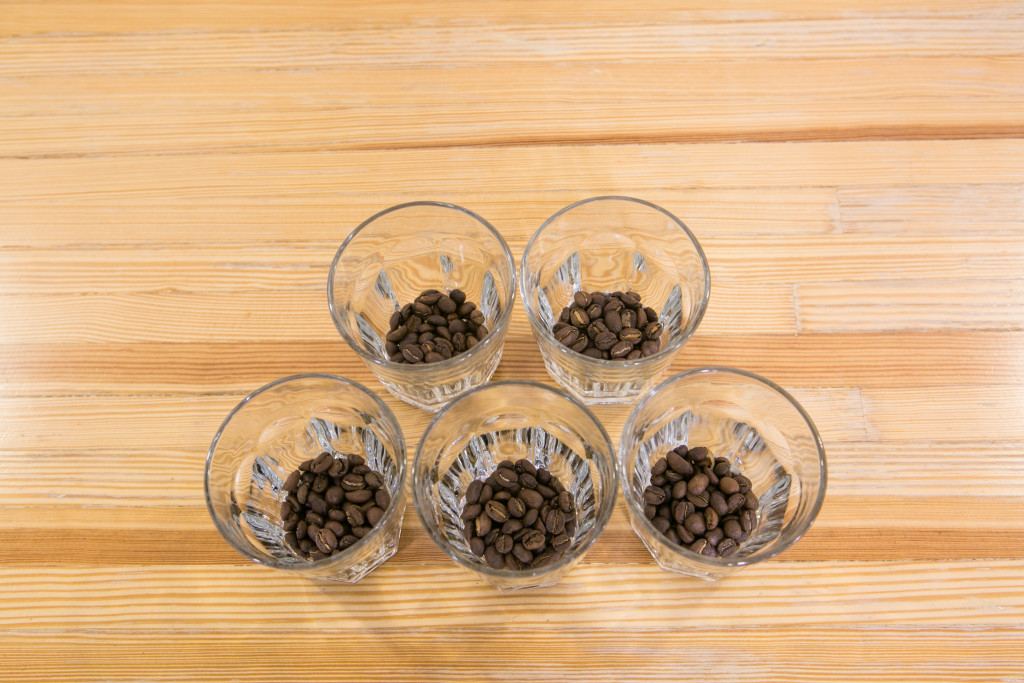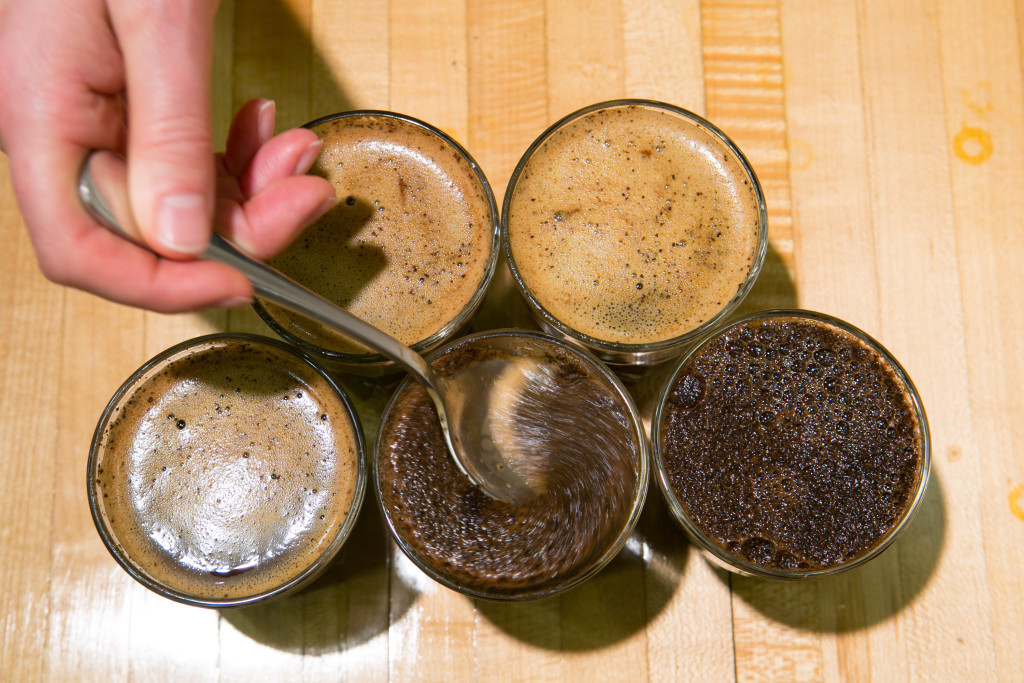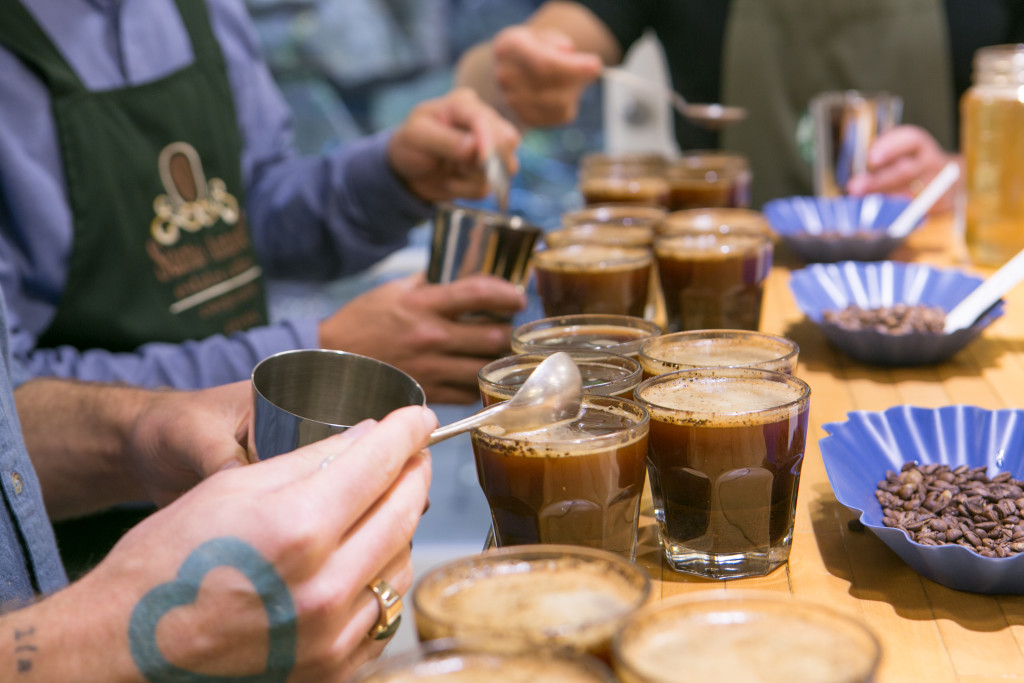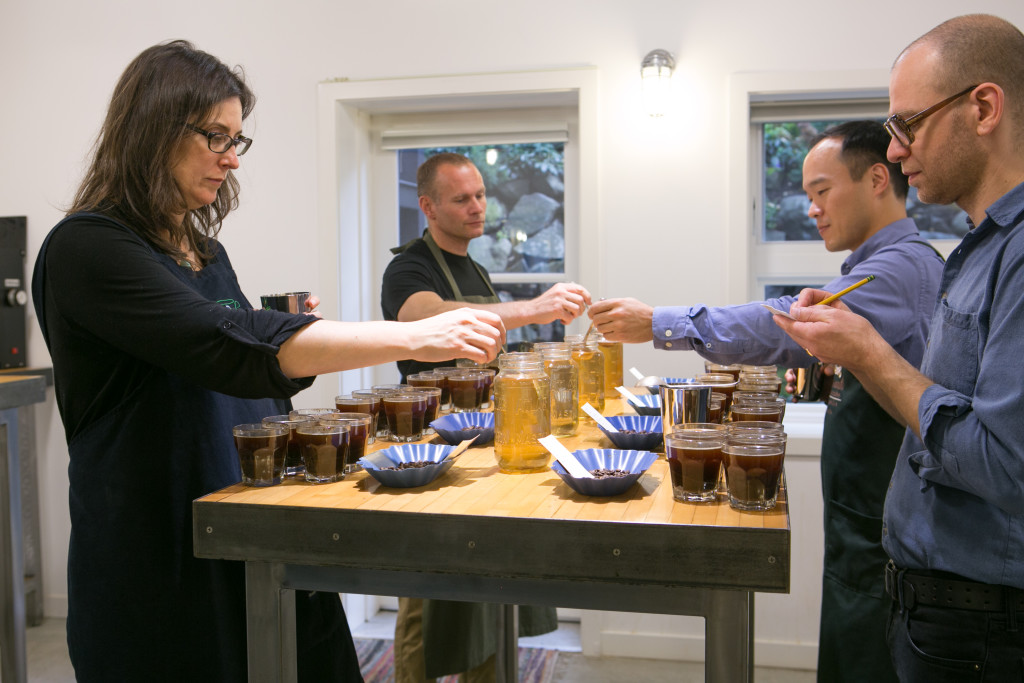Cupping is the industry term for the sensory evaluation of coffee. It is an act that facilitates essential communication between partners in the coffee supply chain. The established method and protocol for cupping have become the basic grammar for a common language used all over the globe to assess the quality of coffee. In addition to quality assessment, the practice of cupping can be used for purchasing, blend or profile development, QC of roasted product, and education.
Coffee cannot be cupped unless it has been roasted. Cupping roasts should be light with adequate development, and essentially as neutral a presentation as possible. For best results, coffee requires a resting period of at least eight hours between roasting and cupping.
Step 1

A critical aspect of cupping is appraising whether a coffee is consistent and free of defects. For this reason, it is standard to set up five cups for each individual lot sample. The coffee is dosed into each cup as whole beans and then ground one cup at a time. If the coffee were to be ground prior to dosing it would homogenize any defects or inconsistencies. Instead, the accepted protocol is to grind a cup at a time in order to isolate any defects and acquire a true picture of how consistent a lot of coffee is.
Step 2

The coffee is not ground until the evaluation is ready to begin, as the most volatile aromatic substances will quickly dissipate even at room temperature. Evaluation begins with an appraisal of the fragrance of the dry coffee grounds. While in day-to day conversation, we consider fragrance and aroma to be synonyms; in cupping they are technical terms that describe the olfactory experience of the dry and brewed coffee respectively.
Step 3

Once the fragrance has been noted, it is time to pour water that is between 195 and 205 degrees Fahrenheit, filling all the cups evenly, and making sure to wet all the grounds. The coffee is then allowed to steep for four minutes, as per SCAA protocol.
Step 4
 The grounds float to the surface forming what is called the crust. The crust traps many of the volatile components that are activated by the temperature and presence of the water. After the coffee steeps for four minutes, the cupper breaks the crust with a spoon using a gentle and superficial stirring motion. It is important to make sure your nose is very close to the surface of the solution in order to gather as much sensory information as possible. It’s at this point that we’re evaluating the aroma.
The grounds float to the surface forming what is called the crust. The crust traps many of the volatile components that are activated by the temperature and presence of the water. After the coffee steeps for four minutes, the cupper breaks the crust with a spoon using a gentle and superficial stirring motion. It is important to make sure your nose is very close to the surface of the solution in order to gather as much sensory information as possible. It’s at this point that we’re evaluating the aroma.
Step 5

Any lingering foam or grounds must be skimmed off the surface with a spoon prior to tasting. This activity also allows time for the coffee to cool to a palatable temperature.
Step 6

Tasting is done by taking a few milliliters of coffee into the bowl of a spoon and slurping it with a bold and vigorous, if not obnoxious, slurping sound. Perhaps the most attractive aspect of cupping is the spitting that attends it. Cuppers spit into a cup or spittoon to avoid over-caffeination during cupping sessions. After tasting each individual cup, the cupper must rinse their spoon is a rinse well of hot water before moving on to the next cup.
Step 7

It is helpful to taste each coffee three times as it cools from hot to room temperature. Some coffees improve as they cool, while others decline as they cool. Tasting each coffee sample multiple times also affords the opportunity to give all attributes their due attention.
When evaluating a coffee, cuppers have to consider and rate a number of attributes. After noting the fragrance and aroma, a cupper tastes and assesses the flavor of the coffee. Next, the aftertaste is considered, which is the sensation that lingers on the tongue after the coffee is swallowed or spit. Following this, the quality and intensity of the acidity needs to be appraised. Acidity is the vitality of the coffee. When assessing the body of a coffee, both the weight and the texture need to be considered. Under the heading of balance, cuppers record an impression of how well all the attributes work together as a cohesive whole. All of these attributes are graded, described and recorded on a cupping form for the sake of communication and future retrieval.
In order to ensure that the cupping practice generates results that are valid and useful, it’s important to proceed in a scientific manner. The objective should be, as much as possible, to limit all other variables besides the lot of coffee that is being evaluated. The same glasses or ceramic bowls should be used, the same grind, and the same coffee to water ratio. The SCAA standard is 8-8.5 g of coffee for every 150 mL of water (it is always important to check how much water can fit in a cupping vessel along with ground coffee and adjust amounts to ensure that the ratio is consistent). The same water at the same temperature should be delivered to all the cups. Care should be taken to avoid any aberrations that could cloud the evaluation process
While cupping may seem like the exclusive domain of a few unique people gifted with freakish sensory acuity, the reality is anyone can learn to cup with a little diligence. Like developing skills in sports or music, the skill of cupping is something that is very much learned. While there might be a few naturals, no one starts out proficient, and competence is only awarded through practice.
An essential part of competence is the development of sensory memory and cupping vocabulary. The first step is cultivating a mindfulness about what we taste and smell. Once we begin to truly notice the character of things - like the flavor of a ripe strawberry or the pungent aroma of cloves - and accurately commit that experience to memory, we begin to cultivate a sensory memory. You cannot recognize someone that you have never met. However, when you develop a robust catalogue of previous sensory experiences, you will have a useful tool to engage in the effort of cupping coffee.
In tandem with the development of sensory memory recall, it is important to hone our sensory language. Acquiring base impressions is not useful until we can label them for efficient communication with others. Cupping is, at its core, about communication. It’s important not only to recognize that you have had a sensory experience before, but to be able to name that experience in a way that others can appreciate and understand.